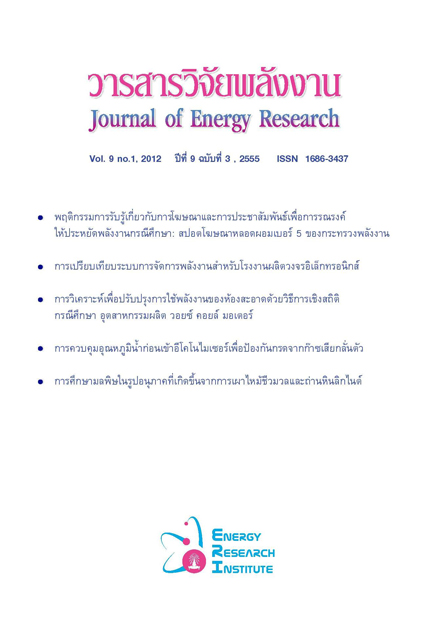การศึกษามลพิษในรูปอนุภาคที่เกิดขึ้นจากการ เผาไหม้ชีวมวลและถ่านหินลิกไนต์
Main Article Content
Abstract
งานวิจัยนี้เป็นการศึกษา ลักษณะของการเผาไหม้ ปริมาณและการเกิดอนุภาคระหว่างการเผาไหม้ถ่านหินลิกไนต์ และชีวมวล 3 ชนิด ได้แก่ แกลบ กากอ้อย และใยปาล์ม และการเผาไหม้ร่วมกันของเชื้อเพลิงดังกล่าวที่อัตราส่วนผสมร้อยละ 50 โดยทำการเผาไหม้แบบแบทช์ในเตาเผาเพื่อศึกษาปริมาณอนุภาคที่เกิดขึ้น และทำการเผาไหม้ด้วยเครื่อง Thermogravimetric-Differential Thermal Analysis (TG-DTA) ที่เชื่อมต่อกับเครื่องวัดปริมาณตามขนาดอนุภาค Scanning Mobility Particle Sizer (SMPS) เพื่อศึกษาลักษณะของการเผาไหม้และการเกิดอนุภาคระหว่างการเผาไหม้ ผลการศึกษาพบว่าปริมาณอนุภาคที่เกิดขึ้นจากการเผาไหม้กากอ้อยมีปริมาณมากที่สุด รองลงมาคือ ใยปาล์ม แกลบ และถ่านหินลิกไนต์ โดยมีปริมาณอนุภาคเท่ากับ 58.3, 36.0, 12.6 และ 10.4 มิลลิกรัมต่อกรัมเชื้อเพลิงตามลำดับ และในการเผาไหม้ของเชื้อเพลิงทุกชนิดพบว่าปริมาณอนุภาคละเอียด (dp1.1 ไมครอน)โดยน้ำหนัก จากการศึกษาลักษณะการเผาไหม้และการเกิดอนุภาคพบว่ามีการเผาไหม้ของชีวมวลเริ่มขึ้นที่อุณหภูมิใกล้เคียงกับการเผาไหม้ถ่านหินลิกไนต์ แต่การเผาไหม้ชาร์ของถ่านลิกไนต์เกิดขึ้นที่อุณหภูมิสูงกว่าชีวมวล การเผาไหม้ชีวมวลและถ่านหินลิกไนต์อย่างใดอย่างหนึ่งเพียงชนิดเดียวก่อให้เกิดอนุภาคมากที่สุดที่อุณหภูมิประมาณ 270oC สำหรับชีวมวล และที่อุณหภูมิ 400oC สำหรับถ่านหินลิกไนต์ สำหรับการเผาไหม้ร่วมกันพบว่าอุณหภูมิที่เกิดอนุภาคมากที่สุดนั้นต่ำกว่าการเผาไหม้ถ่านหินลิกไนต์และสูงกว่าการเผาไหม้ชีวมวลเพียงอย่างเดียว
Characteristics of particles generated during combustion of biomass, lignite coal and co-combustion of lignite coal and biomass
Pattaraporn Saetiew1, Mitsuhiko Hata2, Furuuchi Masami2 and Achariya Suriyawong1
1Department of Environmental Engineering, Faculty of Engineering, Chulalongkorn University, Phayathai Road, Pathumwan, Bangkok 10330, Thailand.
2Graduate School of Natural Science and Technology, Kanazawa University, Kakuma-machi, Kanazawa, Ishikawa 920-1192, Japan.
This study investigated characteristic of particles generated during combustion and co-combustion of lignite coal and three types of agricultural by-products, including rice husk, bagasse, and palm oil fiber. Experiments were conducted using a lab-scale furnace connected to a cascade impactor to quantify amount of particles generated from combustion process at different size-range, and a Thermogravimetric-Differential Thermal Analysis (TG-DTA) connected to a Scanning Mobility Particle Sizer (SMPS) to identify combustion characteristics and to measure particles generated during combustion. Experimental results showed that combustion of bagasse generated the highest amount particles (58.3 mg/g fuel), followed by palm-oil-fiber (36.0 mg/g fuel), rice husk (12.6 mg/g fuel) and lignite coal (10.4 mg/g fuel); and the amount of the fine ash (dp1.1micron) for all combustion experiments. For all investigated biomass and lignite coal, combustion process started generating particle at similar temperature, while char combustion of lignite coal occurred at higher temperature than that of investigated biomass. The highest particle number concentration was found at combustion temperature around 270oC for all investigated biomass, and approximately 400oC for lignite coal. For co-combustion of biomass and lignite coal, combustion temperature that generated the highest particle number concentration was found lower than lignite coal combustion, but higher than biomass combustion.

